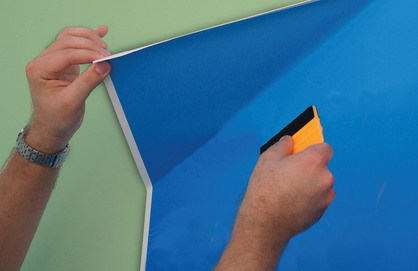So, we’re mainstream. We’re everywhere. Television, magazines, Internet, airports, bus shelters, heck, we’re even on YouTube! Who, you ask? All of us in the signage and graphics industry, that’s who. Whether you produce graphics, sell supplies or just handle the installation, your work can be seen anywhere and everywhere.
Speaking of everywhere, this month we’re talking about graphics that are produced for the most ubiquitous spaces around us – windows and walls. We’ll take a look at some special considerations when using either of these venues for your canvas, and also, the best types of pressure-sensitive adhesive (PSA) vinyl for these applications. So, stop patting yourself on the back for a minute, and let’s see what we can learn.
Let’s talk walls first. Graphics can be applied to many different wall types, so understanding adhesion will give you much better chances to succeed, and to meet your client’s needs.
Indoors, most walls are painted drywall, typically matte latex paint. PSA vinyl can be applied to latex paint, but the wall should be primed before the latex paint is applied. Always ask your customer exactly how the wall was prepared before you even suggest a particular type of graphic. For full-coverage graphics, such as a wall mural, it’s always best to choose an acrylic enamel with a gloss finish.
Once the drywall is ready for a graphics package, determine how long the customer wants the graphics to last. For long-term, permanent applications, choose either an intermediate or ultra-calendered product with a permanent adhesive. If it’s a digital print, always choose a brand-matching laminate, as that print will be continually touched, poked and prodded by all the “Little Johnnys” of the world. Tell your customer the underlying paint will probably be damaged upon removal.
Advertisement
For shorter-term applications, where customers specify frequent graphics changes, or, if they can’t risk any damage to the underlying paint, use a film with a removable adhesive. The application’s duration will determine if the product should be an economy or intermediate film. The shorter the life, the less expensive the vinyl needs to be.
The latest film technology for painted-drywall applications features a very low-tack adhesive that can be applied and re-applied without damaging the underlying paint (think Fathead). These films work great with the matte-latex paint common in most offices and homes, and, lately, we’ve seen a surge in interior and architectural-design vinyl applications.
Instead of using vinyl for utilitarian purposes, such as real-estate signs, shops are working with design firms to make both home and office spaces more aesthetically pleasing. This can be seen with matte-finish plotter films, available in many colors, to be used as either accent striping or as borders on walls to define a space. Matte-finish films will reduce any glare from overhead lighting.
Nowadays, even mild- or coarse- textured walls are screaming for graphic coverage. These plaster walls must be primed and painted for anything to stick to it effectively. You can select vinyl two ways for this type of wall. Use a cast vinyl, whether it’s a plotter-cut graphic or a digital print, and use dry application. Due to the cast film’s highly conformable characteristics, you can work the graphic into the different textures of the wall by simply using a heat gun to warm the graphic up (just enough where you can see the vinyl relax), then use either a rivet brush or your trusty thumb (yes, thumb, and try not to burn the little guy; you may need him later) and push the graphic into the channels and crevices of the wall. Please note this is a permanent application. It may damage the paint upon removal.
To avoid wall damage, use a PSA vinyl with removable adhesive. However, work with your vinyl manufacturer to ensure the face film is as soft as possible, so the material can conform, as much as possible, to any irregular surfaces. Stay away from the highly textured surfaces when using removable adhesives – stucco-type finishes and mild, stippled surfaces are okay – but anything more extreme may cause the graphic to lift, then subsequently fail.
Advertisement
Other building surfaces perfect for adding design elements (man, I gotta stop watching HGTV!) are windows. For interior windows that receive substantial natural light, transparent films are a great choice. These films differ from translucent films because they don’t diffuse light, but let it pass through to achieve a stained-glass look. For interior windows or glass partitions, etched-glass vinyl films are great for either design or privacy reasons. These films are available in coarse or fine textures, and such colors as pastel blue, pink and yellow.
As with all films, it’s best to apply them dry. However, with glass, acrylics and polycarbonates, you may need to use a wet application, especially if you’re applying a large sheet. Simply mix two tablespoons of household dish detergent in a quart of clean water. Choose a detergent free of moisturizers or lotions, and always check with your vinyl manufacturer to verify proper handling and application guidelines. Once you’ve applied the vinyl to the glass, always go back over it with a squeegee to ensure you’ve removed as much application fluid as possible for faster drying times and to avoid any potential bubbles.
Specialty-vinyl applications have invaded home and office design. The more product knowledge you have, the more options you can offer your customers. Many films we’ve discussed can be found way in the back of that color card you have sitting on your desk, beneath that pile of paper with coffee cup sitting on top. I’m sure you have plenty of wall space in your shop, so get a roll and practice.
Get on the mailing or email list of your favorite vinyl manufacturer to make sure you receive up-to-date information on new products or changes in existing product information (changes actually occur quite often). No matter how you get the information, the important thing is that you do, then you can offer new products and ideas to your customer that maybe your competitor hasn’t. So, go on, continue with the back patting, feel confident, secure and, well … patted.


 Tip Sheet4 days ago
Tip Sheet4 days ago
 Business Management2 weeks ago
Business Management2 weeks ago
 Real Deal5 days ago
Real Deal5 days ago
 Women in Signs2 weeks ago
Women in Signs2 weeks ago
 Benchmarks1 day ago
Benchmarks1 day ago
 Editor's Note1 week ago
Editor's Note1 week ago
 Women in Signs5 days ago
Women in Signs5 days ago
 Line Time2 weeks ago
Line Time2 weeks ago


















